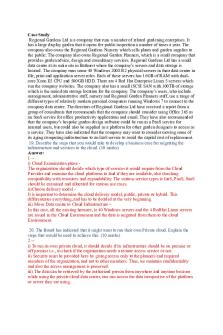1616312150114 A drifting cloud PDF

| Title | 1616312150114 A drifting cloud |
|---|---|
| Author | Trey Craig-Gray |
| Course | Japanese Literature in Translation–Modern |
| Institution | University of Hawaii at Manoa |
| Pages | 4 |
| File Size | 80 KB |
| File Type | |
| Total Downloads | 94 |
| Total Views | 166 |
Summary
Drifting Cloud...
Description
A good text can attract our attention and teach us important lessons about life. The Drifting Cloud is the first modern novel in Japanese history. As the title itself reflects just like a cloud that moves the winds and has no fixed directions, there are people among us who are like these clouds. We must never be excited by seeing a cloud as this cloud can be carried away with the wind above it. These clouds have no fixed position of their own; they cannot decide their future and always move with the wind. Similarly, people who move with the winds of society considered themselves free and independent. But their decisions are greatly affected by their surroundings. They always follow others based on their higher position in society and financial conditions. They are loyal to no one. We must abstain from liking such people as they are fickle. As we have read in this story about Omasa and her daughter Osei. Omasa, earlier wanted her daughter to marry Bonzu because at that Bonzu was a government servant and was earning good money. Later on, when he lost his job, his cousin Osei and aunt Omasa gave him nothing but contempt. They both stopped caring about Bonzu looked down upon him. In the same way, they chose another person, Honda Noboru, because he was financially strong at that time. Regardless of the inner deficiencies of Noboru, Osei started liking him and enjoying his company. Omasa and Osei pay no heed to this aggressive sycophant. Similarly, when Noboru met his senior at the sight of chrysanthemum, he started bowing in front of his boss out of reverence. The same man who was acting like a tough-looking guy suddenly changed into a docile person coaxing and acting as a child in front of his senior. The fickle Noboru then shifted his priority from Osei to his senior and even failed to remember that he was accompanied by both these ladies. Osei and Omasa who went there with Noburu could not do anything but to act like a stranger. Noboru was behaving like a drifting cloud.
In this novel, the writer has beautifully explained that live a mixture of people from all walks of life. Different people are belonging to different cultures and backgrounds adding diversity to life. This combination of people belonging to all walks of life is what adds color to the beauty of life. “What a crowd! What a crowd! Shaven head priests had come and long haired men, men with half shaven heads and men with topknot. And they had come those beloved of the gods, the darlings o the destiny, the men among men and objects of universal esteem and cynosures of envy-I mean they who in days of yore we called liegemen, but who now are our so-called officials, and who may in future generation be styled ‘Public Servants’. Businessmen came and the meek and the humble. There Came also exposed politicians whose principal is not to look, anyone In the face and who have forgotten themselves and their families. The The whole world had come. All kinds of faces hair-dos arranged to all kinds Of fancies, costumes, and scents of every conceivable description-but I do not have the leisure to describe them all.” While the working class does not have the leisure to enjoy this. They can only look out of their windows for a short period. In this story, the writer also explained that the poor are so absorbed in their everyday routines that they cannot enjoy the beauty of life. They envisage the beauty of nature as an opportunity to
earn livelihoods in order to make a decent living. They do not have the leisure and privileges as enjoyed by their peers belonging to rich families. The writer tells us that during the season of chrysanthemum, these people were waving flags to attract some customers. They seemed so disturbed and no one knows why they made so much noise. This teaches us that how our socioeconomics conditions formulate our concepts of life. The reality is not the same for all the persons. I came to know that our perceptions of the outer world are often deceptive. We got carried away by looking at the external features of the persons. People wear expensive and stylish outfits; they put high makeups on their faces just to look pretty. As Omasa advised her daughter to put more make-up although she was looking pretty. But, as her mother has seen a girl who was looking prettier than her daughter because of makeup, Omasa wanted her daughter to be more beautiful. It can be said that we all are materialistic. We behave differently in different situations, sometimes we act aggressively and tough looking while on other occasions we tend to please others. Our attitude towards others is greatly affected by the social status of other persons. I came to know that public servants and politicians have been enjoying high status from time immemorial. The writer has called them darlings of destiny and gods. They have been enjoying luxuries of life that are not available to commoners. As we have seen in the story that most people act like a drifting cloud; they do not have a fixed position and can be carried away with the moving wings of society. They prefer to observe the social status and outer looks of others. They are fickle are disloyal to many people. The only thing that can attract them is materialism. The world is a mixture of people from all walks of life.
Life is sustainable by the combination of all these people. Different people perceive reality differently and this ability of there is greatly affected by the social and economical conditions of human beings. People behave aggressively with people of lower status and pay great homage and reverence to those are in the upper tiers of society. Life teaches us great lessons about life and is the best teacher.
References FUMIKO, HAYASHI, and LANE DUNLOP. Floating Clouds . Columbia University Press, 2006. https://doi.org/10.7312/haya13628. Mueller, Simone, and Sandra Zemp. “Futabatei Shimei and the ‘Superfluous Man’ as a Critique of Modernity,” 2017. “To What Extent Is Futabatei’s Ukigumo, Japan’s First... | Bartleby.” Accessed March 21, 2021. https://www.bartleby.com/essay/To-What-Extent-Is-Futabateis-Ukigumo-Japans-FKCE8643TC. Unknown. “Tony’s Reading List: ‘Ukigumo’ ('The Drifting Cloud’) by Shimei Futabatei & Marleigh Ryan (Review).” Tony’s Reading List (blog), January 3, 2013. http://tonysreadinglist.blogspot.com/2013/01/ukigumo-drifting-cloud-by-shimei.html....
Similar Free PDFs

1616312150114 A drifting cloud
- 4 Pages

Cloud Computing - Grade: A
- 10 Pages

Cloud Computing Essay - Grade: A
- 3 Pages

MCQ-Cloud - Cloud computing MCQ\'s
- 16 Pages

Cloud removal
- 8 Pages

Cloud computing
- 2 Pages

Cloud - important
- 14 Pages

CLOUD COMPUTING.docx
- 23 Pages

Cloud Burst
- 20 Pages

Cloud computing seminar
- 24 Pages

cloud computing security issues
- 3 Pages
Popular Institutions
- Tinajero National High School - Annex
- Politeknik Caltex Riau
- Yokohama City University
- SGT University
- University of Al-Qadisiyah
- Divine Word College of Vigan
- Techniek College Rotterdam
- Universidade de Santiago
- Universiti Teknologi MARA Cawangan Johor Kampus Pasir Gudang
- Poltekkes Kemenkes Yogyakarta
- Baguio City National High School
- Colegio san marcos
- preparatoria uno
- Centro de Bachillerato Tecnológico Industrial y de Servicios No. 107
- Dalian Maritime University
- Quang Trung Secondary School
- Colegio Tecnológico en Informática
- Corporación Regional de Educación Superior
- Grupo CEDVA
- Dar Al Uloom University
- Centro de Estudios Preuniversitarios de la Universidad Nacional de Ingeniería
- 上智大学
- Aakash International School, Nuna Majara
- San Felipe Neri Catholic School
- Kang Chiao International School - New Taipei City
- Misamis Occidental National High School
- Institución Educativa Escuela Normal Juan Ladrilleros
- Kolehiyo ng Pantukan
- Batanes State College
- Instituto Continental
- Sekolah Menengah Kejuruan Kesehatan Kaltara (Tarakan)
- Colegio de La Inmaculada Concepcion - Cebu




